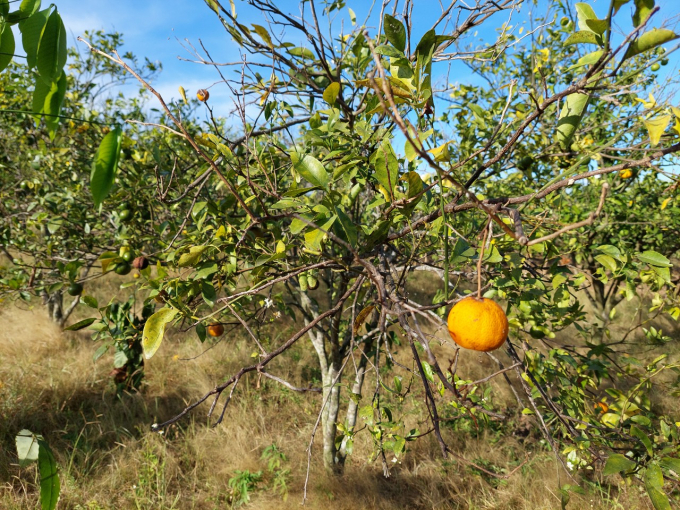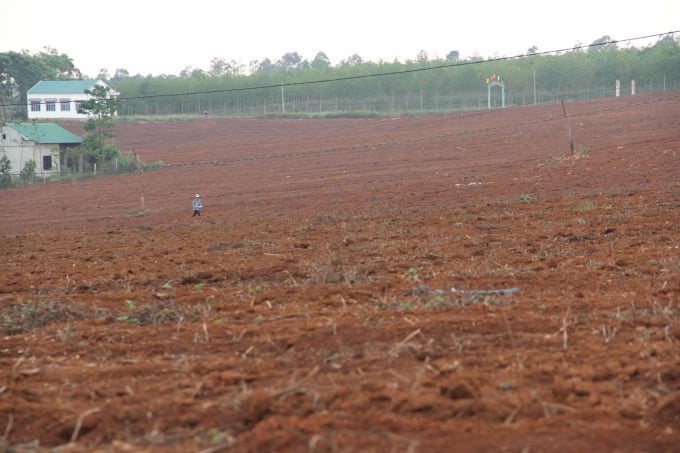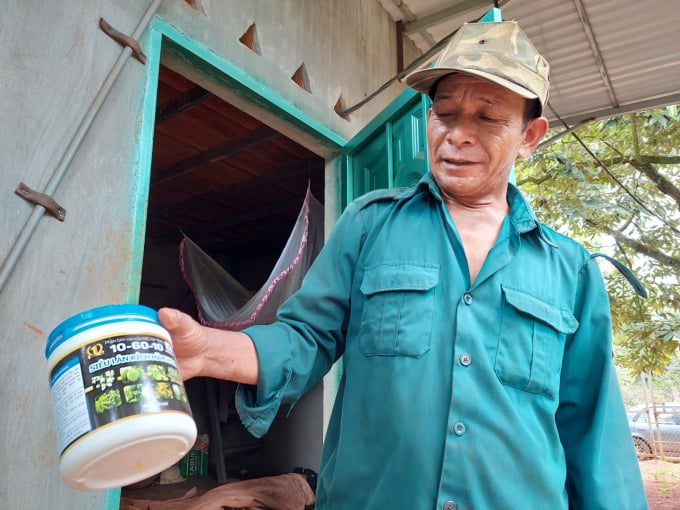May 28, 2025 | 18:08 GMT +7
May 28, 2025 | 18:08 GMT +7
Hotline: 0913.378.918
May 28, 2025 | 18:08 GMT +7
Hotline: 0913.378.918

Chemical fertilizer and pesticide abuse may result in unimaginable consequences. Photo: Hoang Anh.
In a recent interview with Vietnam Agriculture News, Dr. Trinh Cong Tu, Soils and Fertilizers Research Institute (SFRI) - Central Highlands, stated that reducing contamination and toxicity in Central Highlands soil is an urgent task that will step by step improve and stabilize agroproduction in the area.
“There are many causes of soil pollution such as the influence of industrial and domestic waste as well as agrochemical residues. However, the irrational use of chemicals in cultivation is the most common cause of environmental damage in general and soil contamination in particular. In the process of using fertilizers and pesticides, toxic substances infiltrate the soil quickly but take a long time to decompose, creating significant residues, thus causing biological magnification.”
In pursuit of high yield, Central Highlands people are not hesitant to invest a large amount of agrochemicals into their field. The soil soon loses its texture as a result, becoming more hardened. Water and fertilizer retention are worsening. Eutrophication of heavy metals and residues of pesticides appears. The environment is destroyed, and beneficial flora and fauna in the soil are seriously reduced.
Those impacts may seem hard to detect at first, but the adverse effects on crop growth and development soon become vivid. Crop productivity and agro-product quality reduce quickly over time, in many cases only negative effects remain.
The productive capacity of the land has been depleted to the point that recultivation is deemed impossible. Research by the Western Highlands Agriculture and Forestry Science Institute (WASI) shows that nearly 80% of farmers use chemical fertilizers for coffee with a total amount exceeding the allowed amount in the procedure. This at the same time makes the soil imbalance in the sense of potassium deficiency but nitrogen excess, causing accumulation of nitrate in lake water and domestic wells.

Inappropriate use of chemicals in cultivation causes evident damage to the environment by contaminating the soil. Photo: Minh Quy.
Having a deep understanding of the situation of soil toxicity and contamination, De. Trinh Cong Tu proposed a number of solutions that require immediate implementation.

Limiting pollution and toxicity of the Central Highlands' soil is an issue of great urgency. Photo: Minh Quy.
The first solution concerns the fertilizing stage.
Fertilize the right plant, right soil: Each type of crop and soil is compatible with certain fertilizers, for example leafy greens prefer high-protein fertilizers, and seed crops (coffee, pepper, etc.) have high potassium requirements. Hilly soil often has an acidic reaction so it is necessary to limit the application of acidic fertilizers such as superphosphate, or physiologically acidic such as chlorine salts, and sulphates.
Fertilize the right dose and proportion: Adjustments in the type, dosage and ratio of fertilizers need to be in accordance with each type of crop, on each soil level and in different growth periods.
Fertilize at the right time: Growers should properly and sufficiently meet the nutrients needed for plants in each physiological stage: focus on fertilizing a lot of phosphorus to promote the rooting of seedlings in the early stage; apply a lot of nitrogen to stimulate the growth of leaves in the growing period; fertilize a lot of potassium in the fruiting period.
Fertilize the right way:
If evaporative fertilizers (such as urea) are spread on the ground, there is a high possibility that they will evaporate under the sun, but fertilizing too deep underground may result in losing fertilizer due to gonorrhea. Burying fertilizer at a depth of 5-10 cm is reasonable. As for foliar fertilizers, it is recommended to spray when the weather is cool without rain. The spraying needs to be even to amplify the fertilizer’s effect.
One thing to note is that season and weather also greatly affect the effectiveness of fertilizers. Heavy rain will wash away fertilizers, causing waste and pollution. And during drought or heavily sunny days the soil would not be moist enough to dissolve the fertilizer, unable to take in enough nutrients.

Appropriate use of agro-inputs is the solution to reviving Central Highlands's soil. Photo: Hoang Anh.
The second solution is to organicize the field and minimize the application of chemical fertilizers. The organic cultivation direction is the soil’s most important fertility indicator. Once the organic matter content in the soil is reduced, the soil properties will change in a direction that is detrimental to the growth and development of plants.
Therefore it is necessary to pay close attention to the field and protect organic sources in the soil during the cultivation process. Regular application of manure, oilcake, and fish carcass is a very effective way to stabilize and improve soil organic matter.
The Central Highlands has more than 600,000 ha of coffee, 250,000 ha of rice, and 200,000 ha of corn, producing millions of tons of by-products every year. This is a material source with high organic content, accounting for more than 25% of the dry matter weight, equivalent to the amount of organic matter in peat used by fertilizer production facilities. In addition, this material source also contains 1-2% protein, 3% potassium on average as well as many essential trace elements such as Ca, Mg, Si, S, Zn, B, and Cu.
The third solution is to apply appropriate farming methods. Reasonable intercropping can both diversify sources of income and increase ground coverage which limits the growth of weeds. The crop rotation method helps change the host for pests and diseases thereby saving production costs and minimizing environmental damage caused by chemical pesticides.
The fourth measure is to increase the use of biological products to replace agrochemicals in production. In addition to herbal pesticides such as extracts from neem, garlic and chili, some strains of microorganisms that are the nemesis of pests and diseases should be studied and utilized.
Beneficial microorganisms that are cultured and multiplied to a high cell concentration will be very effective for plant protection and soil amendment preparations. For example, Bacillus thuringiensis (Bt) secretes a fluid containing proteins that repel or harm insects. Phosphorus soluble microorganisms have been cultured and produced, notably VA mycorrhiza, to solve the problem surrounding the situation when red basalt soil and black soil possess high phosphorus content but the plants cannot absorb it because it is in an insoluble form.
The fifth solution is the use of preparations that increase fertilizer performance. Using humate, humectant, and silicon has the effect of improving the resistance of the soil to cold, heat, drought, alum, salinity, and organic toxicity. Foliar fertilizers add growth regulators, antibiotics, vitamins, and amino acids to stimulate plant growth and increase resistance to pests.
Wake up to lessen the toxicity within the land
"I feel great pain while reading the series “The vast Central Highlands and the pain of earth” on Vietnam Agriculture News." That was the first sharing of Dr. Pham Thi Vuong, President of Vietnam Union of Science and Technology Associations (VUSTA).
Reasons were many, but one fact stayed true: No parties involved are innocent when agricultural land is rapidly and extensively degraded due to the current abuse of chemical fertilizers and pesticides.
For a long time, the Central Highlands was a famous industrial crop growing area of Vietnam, shining with information about increased production, high income, and millionaires. At that time, a number of scientists gave out warnings about monoculture, chemical abuse in agroproduction, and excessive use of water, even groundwater for irrigation.
“But those warnings may not be strong enough to put in place solid mechanisms and policies that force us to have obligations and responsibilities to protect and take care of cultivation land, a precious resource. And so to this day, the situation has reached an extremely alarming rate as reflected in the series “The vast Central Highlands and the pain of earth”. We need to wake up to change our own actions and responsibilities toward this precious land. Responsible, green, and circular agriculture may not give a high yield and output in the early years, but it is the right path to revive the ecosystem and stabilize the livelihood of the people. We will slowly but surely return some of the fertility to the soil.”
Translated by Samuel Pham
/2025/05/25/4127-3-073637_820.jpg)
(VAN) Thanks to the promotion from an FAO-implemented project, vegetable production in greenhouses in Moc Chau has seen strong development, from 1.5 hectares in 2021 to nearly 50 hectares in 2024.

(VAN) FAO has recently supported USD 140,000 to implement the project 'Risk mitigation human-animal interface risks through disease control initiatives in pig farming.'

(VAN) The People's Committee of Tra Vinh province has approved an adjustment to the investment policy for the Green Hydrogen Plant project, increasing its area to approximately 52.76 hectares.
![Reducing emissions from rice fields: [2] Farmers’ commitment to the soil](https://t.ex-cdn.com/nongnghiepmoitruong.vn/608w/files/news/2025/05/05/dsc08881jpg-nongnghiep-140632.jpg)
(VAN) Clean rice cultivation model in Thuong Tan commune, Bac Tan Uyen district, is assisting local residents in achieving sustainable agriculture by substantially reducing costs, increasing productivity, and protecting the environment.

(VAN) At the conference to disseminate Resolution No. 68, AgriS introduced its digital agricultural ecosystem and reaffirmed its commitment to accompanying the Government in promoting private sector development and sustainable agriculture.

(VAN) 'Blue Ocean - Blue Foods' initiative is designed to restore marine ecosystems and establish sustainable livelihoods for local communities by cultivating a minimum of 1,000 hectares of cottonii seaweed in the first three years.
/2025/05/21/4642-3-112707_603.jpg)
(VAN) The V-SCOPE project has made direct contributions to three out of six pillars of the Comprehensive Strategic Partnership between Vietnam and Australia.